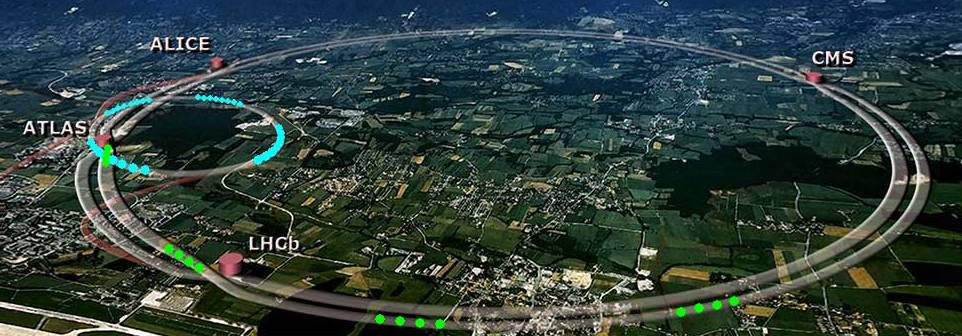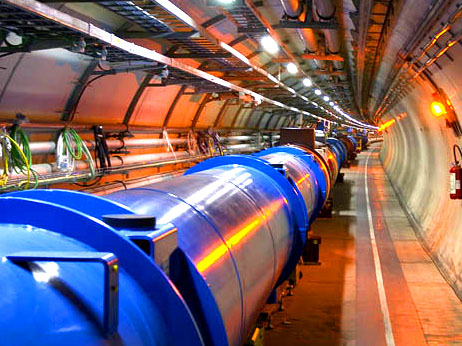The Large Hadron Collider (LHC) at the CERN laboratory in Geneva is well described in detail on their website cern.ch as well as in YouTube videos. I am just giving a brief introduction here for an OLLI class.
The LHC collides mainly protons with protons, coming from opposite directions in their so-called center of mass frame to maximize the total energy for creating new particles. The length of the rings is 27 km or 17 miles. The beams circulate in beam pipes a few inches apart, with the magnetic field up in one pipe, and down in another, so that one beam can be bent in a circle going clockwise, and the other in a neighboring circle going counterclockwise. The beams are made to collide in intersection points for the major experiments ATLAS, CMS, Alice, and LHCb.
It is called the hadron collider, since it will stop running protons in mid-December, and then collide lead nuclei for a few months to simulate the quark-gluon plasma during the early, hot big bang of the universe.
It is currently colliding 4 TeV protons on 4 TeV protons, where a TeV is a tera or trillion electron volts. A billion electron volts is called a GeV or giga electron volts. This is about the rest energy of a proton whose E = mc² is 0.938 GeV. So 4 TeV is 4,000 GeV or about 4,000 times the rest energy of a proton or neutron. The total energy in the detectors or center of mass frame is then 8 TeV, which could create a particle or a pair of particles of multi-TeV mass or masses. The LHC has been running since April at 8 TeV. Last year it ran at 7 TeV. It will shut down next year for magnet and detector upgrades, and in 2015 will start running at 13 or 14 TeV total energy, which is its design energy.
This is the LHC in its slowly curving tunnel. It has 1232 dipole magnets to slowly curve the very high energy protons. The magnets are superconducting to avoid power dissipation and costs and to provide high magnetic fields, and they are surrounded by low temperature liquid Helium.
People are usually curious about how much this work costs. Forbes estimated that by the time the Higgs was discovered, $13 billion had been spent. $5 billion of this was the cost of the LHC collider. $5 billion was the cost of the detectors, and the cost of running the LHC is $1 billion a year. Forbes opined that discovering the laws of the universe was worth the cost, and compared it to the yearly budget of NASA at $17 billion, and to 2.2% of the US military budget. The US high energy physics budget is about $800 million a year.
Their analysis ignored the technological progress, training, and establishment of technical manufacturing capabilities in the contributing countries and institutions. We should remember that the internet was invented at CERN as a way to share data among the worldwide collaborators in its experiments.


